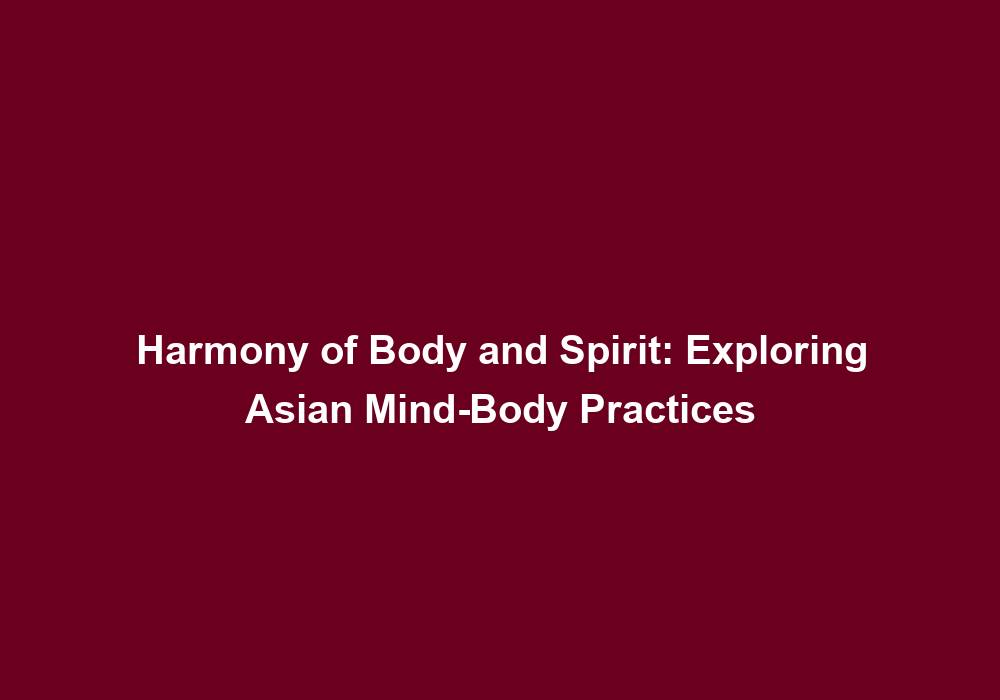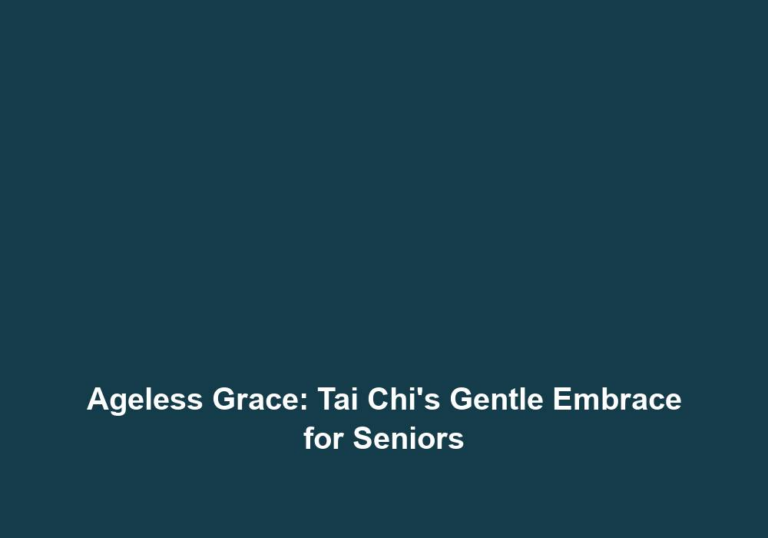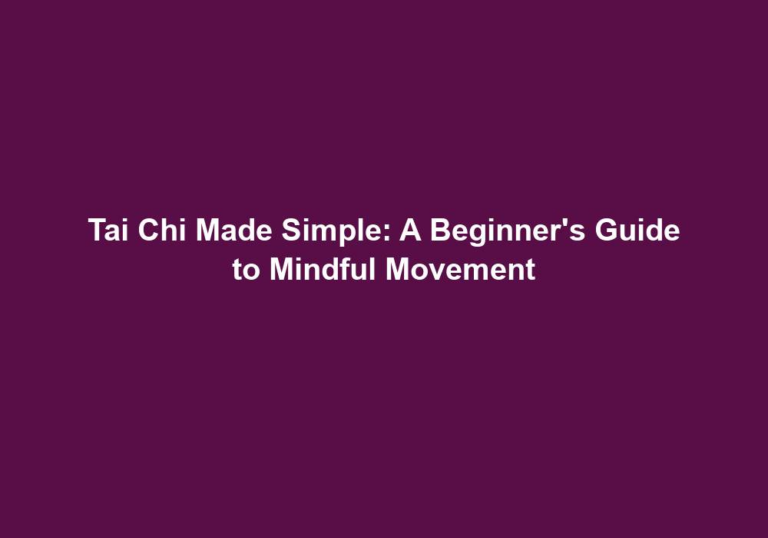Harmony of Body and Spirit: Exploring Asian Mind-Body Practices
In today’s fast-paced world, finding inner peace and achieving a harmonious balance between the body and spirit has become increasingly important. The pressures of daily life can often leave us feeling stressed, overwhelmed, and disconnected from ourselves. To combat this, many individuals have turned to ancient Asian mind-body practices that offer a profound sense of wellness and tranquility. This article delves into the world of Asian mind-body practices, exploring their origins, benefits, and how they can be incorporated into our modern lives.
Understanding Asian Mind-Body Practices
Asian mind-body practices encompass a wide range of disciplines and techniques that have been developed and refined over thousands of years. These practices, rooted in various Asian cultures, aim to establish a deep connection between the mind, body, and spirit. They emphasize the interplay between physical movements, breath control, meditation, and mindfulness, all of which contribute to overall well-being.
The interplay between physical movements, breath control, meditation, and mindfulness forms the foundation of Asian mind-body practices. By engaging in these practices, individuals can cultivate a harmonious relationship between their mind, body, and spirit. Physical movements, such as the postures in yoga or the fluid movements in Tai Chi, promote flexibility, strength, balance, and coordination. Breath control techniques, like pranayama in yoga or deep breathing in Qigong, help regulate the flow of vital energy (Qi) within the body. Meditation and mindfulness practices train the mind to focus, redirect thoughts, and reach a state of deep relaxation and heightened awareness.
The Origins and Philosophy Behind Asian Mind-Body Practices
- ### Yoga: The Ancient Science of Union
Originating in ancient India, yoga is perhaps the most well-known Asian mind-body practice. Rooted in Hindu philosophy, yoga seeks to unite the individual consciousness with the universal consciousness. It comprises physical postures (asanas), breath control (pranayama), and meditation techniques that promote physical strength, flexibility, mental clarity, and emotional balance.
Yoga is not just a physical exercise; it is a holistic practice that encompasses the body, mind, and spirit. The physical postures, or asanas, help improve flexibility, strength, and balance while also promoting proper alignment and posture. Breath control techniques, such as pranayama, enhance the flow of vital energy (Prana) within the body, increasing vitality and promoting overall well-being. Meditation techniques in yoga cultivate mental clarity, reduce stress, and foster emotional balance. By integrating these elements, yoga offers a comprehensive approach to achieving physical, mental, and emotional harmony.
- ### Tai Chi: Embracing the Flow of Energy
Tai Chi, originating in China, is a martial art that combines deep breathing, slow and fluid movements, and focused attention. Based on Taoist principles, Tai Chi aims to balance the flow of vital energy (Qi) within the body, promoting relaxation, inner calmness, and improved physical health.
Tai Chi is often described as “meditation in motion” due to its slow and graceful movements. The practice involves shifting weight from one leg to another while maintaining a relaxed and upright posture. By focusing on the breath and the flow of energy, practitioners cultivate a sense of mindfulness and inner peace. The gentle, flowing movements of Tai Chi promote flexibility, balance, and coordination while also strengthening the muscles and improving overall physical health.
- ### Qigong: Cultivating Life Energy
Qigong, also originating in China, is a holistic mind-body practice that involves coordinated movements, deep breathing, and meditation. With roots in traditional Chinese medicine and philosophy, Qigong aims to cultivate and balance the body’s vital energy (Qi) to enhance physical health, mental clarity, and spiritual well-being.
Qigong combines gentle physical movements, deep breathing, and focused intention to cultivate and balance the body’s vital energy. These movements are designed to open up energy pathways, remove blockages, and promote the smooth flow of Qi throughout the body. Through regular practice, individuals can improve their overall physical health, boost their immune system, and enhance mental clarity. Qigong also offers a pathway to spiritual well-being by connecting practitioners with their inner selves and the world around them.
- ### Meditation: Quietening the Mind and Awakening the Spirit
Meditation is a practice found in various Asian cultures, including Buddhism, Hinduism, and Taoism. It involves training the mind to focus and redirect thoughts, leading to a state of deep relaxation and heightened awareness. Meditation is known to reduce stress, improve concentration, and promote a sense of inner peace and spiritual growth.
Meditation is a practice that involves calming the mind and focusing on the present moment. By sitting in a quiet and comfortable position, individuals can cultivate a sense of stillness and awareness. There are various meditation techniques, such as mindfulness meditation, loving-kindness meditation, and transcendental meditation, each with its own approach and benefits. Regular meditation practice can help reduce stress and anxiety, improve concentration and focus, and create a greater sense of inner peace and spiritual connection.
Benefits of Asian Mind-Body Practices
Asian mind-body practices offer numerous benefits to individuals who incorporate them into their daily lives. Some of the key advantages include:
- ### Physical Well-being
Regular practice of Asian mind-body disciplines can lead to improved physical health. These practices enhance flexibility, strength, balance, and coordination. They can also help alleviate chronic pain, boost the immune system, and promote better sleep patterns.
Asian mind-body practices focus on the integration of physical movements, breath control, and meditation to promote physical well-being. The physical postures and movements improve flexibility, strength, balance, and coordination. By engaging in these practices, individuals can also alleviate chronic pain and improve their overall physical health. The deep breathing and relaxation techniques incorporated in these practices help boost the immune system and promote better sleep patterns, leading to improved overall well-being.
- ### Emotional Balance and Mental Clarity
The integration of breath control, meditation, and mindfulness in Asian mind-body practices fosters emotional balance and mental clarity. These practices reduce stress, anxiety, and depression while enhancing overall psychological well-being.
Asian mind-body practices provide a holistic approach to emotional balance and mental well-being. By incorporating breath control techniques, individuals can regulate their emotions and reduce stress and anxiety. Meditation and mindfulness practices train the mind to focus and redirect thoughts, leading to greater clarity and a sense of inner calmness. These practices also promote self-awareness and self-acceptance, fostering a positive mindset and emotional resilience.
- ### Spiritual Growth and Self-Discovery
Asian mind-body practices provide a pathway for spiritual growth and self-discovery. By fostering a deeper connection with oneself and the world around them, practitioners can gain insights into their true nature, purpose, and values.
Asian mind-body practices offer a means to connect with one’s inner self, explore deeper aspects of consciousness, and cultivate a sense of spiritual well-being. Through these practices, individuals can embark on a journey of self-discovery and gain insights into their true nature, purpose, and values. By fostering a deeper connection with oneself and the world, practitioners can cultivate a greater sense of meaning and fulfillment in life.
- ### Stress Reduction and Relaxation
Incorporating Asian mind-body practices into one’s daily routine can significantly reduce stress levels. The cultivation of mindfulness and the release of physical tension through these practices promote relaxation, inner calmness, and an improved ability to cope with life’s challenges.
Asian mind-body practices offer effective tools for stress reduction and relaxation. By incorporating mindfulness into daily activities, individuals can cultivate a sense of presence and awareness, helping them manage stress more effectively. The physical movements and relaxation techniques in these practices release physical tension and promote a state of deep relaxation. Regular practice of these techniques can enhance one’s ability to cope with the challenges of daily life and promote overall well-being.
Incorporating Asian Mind-Body Practices into Modern Life
Despite the demands of modern life, it is essential to make room for Asian mind-body practices. Here are some tips on incorporating these practices into your daily routine:
- ### Set Aside Time for Practice
Allocate dedicated time each day for practicing Asian mind-body techniques. Start with short sessions and gradually increase the duration as you become more comfortable. Consistency is key to experiencing the full benefits.
To incorporate Asian mind-body practices into your daily routine, it is important to set aside dedicated time for practice. Start with short sessions, such as 10-15 minutes, and gradually increase the duration as you become more comfortable. Consistency is key, so aim to practice these techniques daily to experience the full benefits.
- ### Seek Professional Guidance
Consider attending classes or workshops led by experienced instructors to ensure that you learn and practice the techniques correctly. They can guide you on proper form, alignment, and provide personalized instruction to suit your individual needs.
To enhance your practice and ensure proper technique, consider seeking professional guidance. Attending classes or workshops led by experienced instructors can provide valuable guidance on proper form, alignment, and personalized instruction. They can help you understand the subtleties of the practice and tailor it to your individual needs, maximizing the benefits you receive.
- ### Create a Peaceful Environment
Designate a quiet, clutter-free space at home where you can practice without distractions. Play soft background music or use aromatherapy to enhance the calming atmosphere.
Creating a peaceful environment for your practice can greatly enhance the experience. Designate a quiet space in your home, free from clutter and distractions, where you can immerse yourself in the practice. Consider playing soft background music or using aromatherapy with calming scents to create a soothing atmosphere that supports your mind-body connection.
- ### Integrate Mindfulness into Daily Activities
Incorporate mindfulness into everyday tasks, such as mindful eating, walking, or even completing household chores. This helps cultivate a sense of presence and awareness throughout the day.
In addition to dedicated practice sessions, it is beneficial to integrate mindfulness into your daily activities. Mindful eating, walking, or even completing household chores can become opportunities for cultivating a sense of presence and awareness. By bringing mindfulness to these activities, you can anchor yourself in the present moment and foster a deeper connection with your mind, body, and surroundings.
- ### Practice Gratitude and Self-Reflection
Take a few moments each day to express gratitude for the present moment and engage in self-reflection. This practice cultivates a positive mindset and deepens your connection with yourself and the world.
To deepen your mind-body connection and cultivate a positive mindset, incorporate gratitude and self-reflection into your daily routine. Take a few moments each day to express gratitude for the present moment and the blessings in your life. Engage in self-reflection to gain insights into your thoughts, emotions, and actions. This practice fosters a deeper connection with yourself and the world around you, promoting overall well-being.
Conclusion
Asian mind-body practices offer a transformative journey towards harmony of the body and spirit. Through disciplines such as yoga, Tai Chi, Qigong, and meditation, individuals can attain physical well-being, emotional balance, and spiritual growth. By incorporating these practices into our daily lives, we can navigate the challenges of the modern world with grace and find solace in the interconnectedness of our inner and outer selves.







